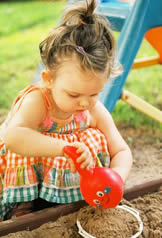CHOOSING TOYS
From Mister Rogers' Neighborhood
 When given the opportunity, children tend to choose playthings that suit their developmental needs. You may have seen a young child put aside a newly acquired toy in favor of the empty carton or the brightly colored wrapping paper. A child may spend a long time playing happily with an empty cereal carton, or banging on a metal pot with a wooden spoon. That's because young children's imaginations are engaged by almost everything they see. In the same way, it's often rewarding for older children to make their own playthings out of everyday household things. That way they can be imaginative and involved in making the toys as well as in playing with them. When given the opportunity, children tend to choose playthings that suit their developmental needs. You may have seen a young child put aside a newly acquired toy in favor of the empty carton or the brightly colored wrapping paper. A child may spend a long time playing happily with an empty cereal carton, or banging on a metal pot with a wooden spoon. That's because young children's imaginations are engaged by almost everything they see. In the same way, it's often rewarding for older children to make their own playthings out of everyday household things. That way they can be imaginative and involved in making the toys as well as in playing with them.
A four-year-old was playing with a toy airplane, making it swoop and dive over and over again. He stopped and looked into the empty cockpit. He couldn't find any little toy figures that could fit into the pilot's seat, so he took a small wooden cylinder from a block set and used it as the pilot. That's how creativity and problem-solving grow -- out of play with simple things.
Children might also use their toys to try to figure out things about the world, try on different roles, or work through some of their feelings and concerns. At other times, their play is just for fun.
Open-Ended Toys
 Children's play depends on what they're needing or thinking about or dealing with at that moment. That's why the very best kinds of playthings are open-ended: blocks or stuffed animals, toy cars, or play clay and art supplies. Children can make of them whatever they need, and their play is then determined by their own needs. If most of their playthings are "single-action" toys, their play tends to be limited, as if they're following the "formula" of what the manufacturer determined. Children's play depends on what they're needing or thinking about or dealing with at that moment. That's why the very best kinds of playthings are open-ended: blocks or stuffed animals, toy cars, or play clay and art supplies. Children can make of them whatever they need, and their play is then determined by their own needs. If most of their playthings are "single-action" toys, their play tends to be limited, as if they're following the "formula" of what the manufacturer determined.
Time to Play
One way we show that we value our children's play is by offering them toys -- and times -- that can be used in all sorts of imaginative, creative ways. Children sense that we care about their play when we give them quiet time to play, alone or with friends, with no distractions of television or music.
Choosing Toys Wisely
As careful as parents may be about the playthings they offer and the ideas we suggest, children still ask for toys that we might find inappropriate. It can help to remember that just because a child asks for something doesn't mean he or she really wants it or needs it. Children are easily seduced by television ads and peer pressure, even in the preschool years. As parents, we can be honest and let our children know how we feel about those playthings. In that way, we're letting them know some of the important values of the family to which they belong.
Toy Tips
- Before throwing something away, maybe it can be recycled as a plaything. Some of the best toys are inexpensive -- and even free! A paper towel tube can be a tunnel for cars or a trumpet...a big empty box can be an airplane or boat.
- Keep toys in see-through containers. Then children are more likely to go to the boxes to find what they need...and they have an easier way to know where they belong when it's cleanup time.
- Rotate the toys . Periodically stow some away for a while and bring them back out in exchange for others.
- Before going to a store , tell your child ahead of time what you're planning to buy ...and let your child know that's all you're going to buy. Then saying "no" may be easier for you to say and for your child to accept.
|